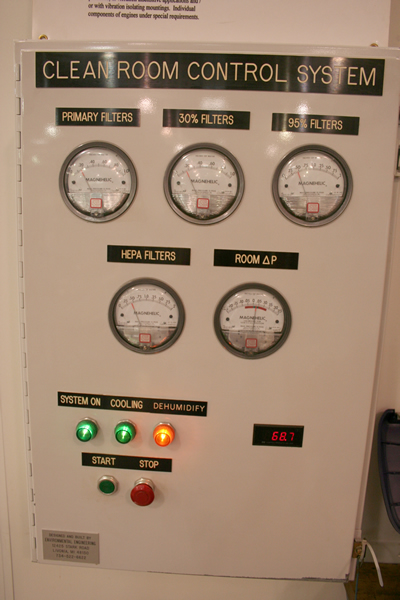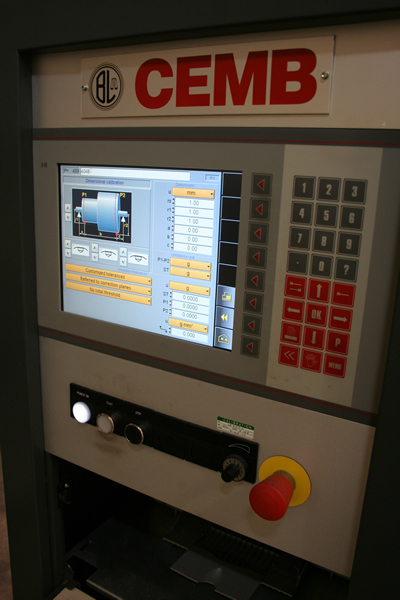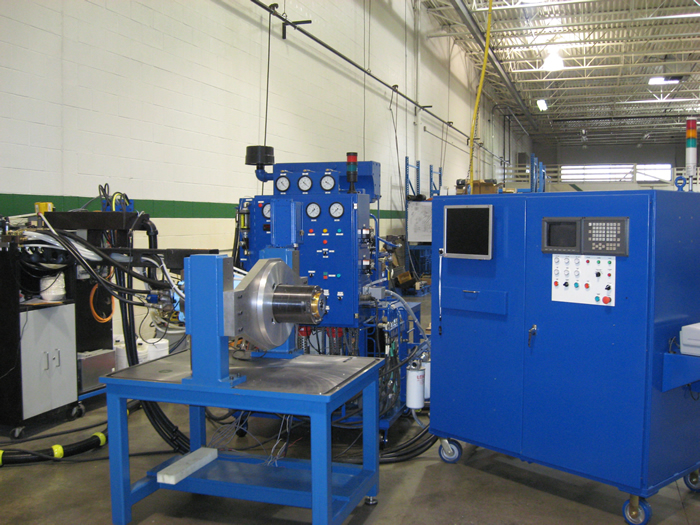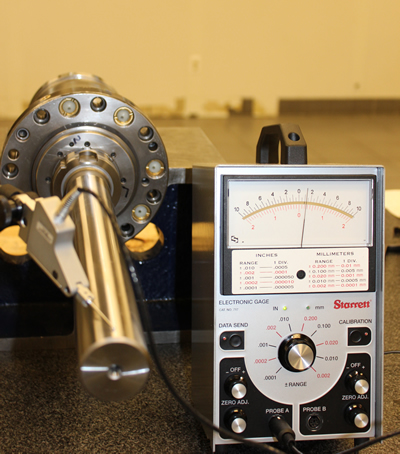Early attention to performance issues and insisting on painstaking rebuild/remanufacturing procedures can help machine tool operators keep their spindles on the job.
For most manufacturers, the productivity of their CNC equipment can be measured in fractions of seconds when it comes to things like cutting or grinding cycle times and the intervals between tool changes. The performance of the spindle—the workhorse of the CNC machine—has a dramatic impact on that productivity.
When operating problems, such as excessive vibration or chatter, hinders machining efficiency, productivity may be crippled until the spindle is replaced. If no spare is available, repairing or remanufacturing the spindle could take weeks, which effectively puts a machine out of business in the meantime. Hence, getting longer life and optimum operating performance from spindles is a worthwhile economic goal for manufacturers.


As reassembly of remanufactured spindles takes place, a clean working environment is essential.

The solution to getting higher performance and extended life from spindles on CNC machines is a combination of practices aimed at (1) preventing premature spindle failure and (2), after a failure occurs, insisting that the remanufacturer provide comprehensive CNC spindle repair services. In addition, the remanufacturer must be able to provide modifications and operational recommendations that can ensure longer spindle wear life—even when run at higher speeds.
The following guidelines can help machine operators achieve these goals.
Identify when to repair—before failure
Normally when a customer pulls a spindle it is because of part quality issues and/or intensified noise level.
“Noise often results from damaged bearings creating vibration that may eventually lead to chatter, a more severe vibration that feeds upon itself,” explains David Kirkpatrick, president of Superior Spindle Service, Taylor, Mich., a company that specializes in rebuilding, grinding and machining of machine tool spindles. “Chatter often creates waves in machined surfaces to the point where the parts are out of tolerance and must be scrapped.”
Another immediate and serious consequence of chatter relates to spindle efficiency. Many manufacturers deal with chatter by setting their machining parameters low. Therefore, instead of tool strength and spindle horsepower defining the metal removal rate, chatter becomes the limiting factor that keeps the process from reaching its potential.


Some spindle remanufacturers, such as Superior Spindle Service, offer one-stop repair services.

Kirkpatrick, a CNC machine spindle expert with more than 30 years of experience adds, “Cutting tool chatter and spindle vibration are indicators that a spindle requires attention or a catastrophic failure can occur.”
In some cases when vibration does not cause a part quality problem, operators have been known to run the machine until it catastrophically fails—a very expensive decision.
The solution for operators of CNC equipment is predictive maintenance. This requires regular monitoring of operating parameters and maintaining disciplined, detailed records. For example, vibration analysis should be monitored and recorded at appropriate intervals, perhaps quarterly or even monthly.
“The frequency of vibration analysis depends on the application,” Kirkpatrick says. “The temperature of the spindle should also be monitored. It is important that an expert determine that the spindle should be switched out before parts go out of tolerance or motor damage occurs. Plus, if the spindle can be changed out over a weekend, the shop can avoid critical downtime.”
Look to a remanufacturing specialist
When CNC spindle repair or replacement is needed, a remanufacturing specialist can often provide more comprehensive spindle services, sometimes also including repair of related motors, encoders, proximity sensors and drawbars.
Some spindle remanufacturers, such as Superior Spindle Service, offer one-stop repair services. As there is a direct relationship between spindle performance and the proper function of these other components, it is critical that the precision spindle repair facility be able to evaluate and service all spindle components.
The evaluation process begins with disassembly of a spindle that is out of spec or has failed. The evaluation could include the motor—surge test, drawbar—retention force and all electronics (encoders, proximity sensors, bearing sensors, etc.).


Getting longer life and optimum operating performance from spindles is a worthwhile economic goal for manufacturers.

“Service technicians meticulously should disassemble and check each spindle for adherence with the original manufacturer’s specifications,” Kirkpatrick explains. “This is followed by a geometric inspection using electronic measuring equipment that is repeatable within a micron. It is advantageous that a digital photo record be kept to ensure that all repair quotes and failure analysis reports are as accurate as possible. Next, grinding, machining and balancing should be performed by experienced technicians using advanced manufacturing equipment.”
It is essential that spindles are reassembled in a clean work environment. For example, at Superior Spindle Service a class 10,000 clean room is used for inspection and assembly. The clean room is designed to prevent any airborne contaminants and humidity from affecting spindle quality and performance, and further ensures that each spindle is returned to precise OEM specifications.
Look for Kaizen-type innovation and improvements
Kirkpatrick says there is much room for Kaizen-type improvement throughout the remanufacturing process. In one case, his firm was working with a major automotive manufacturer who was experiencing excessive downtime—over 31 hours—each time they had to change a spindle.
Superior Spindle Service was able to extend spindle life by incorporating specific modifications. As a result, the customer’s average spindle downtime was reduced to less than 10 hours, an accomplishment for which the spindle remanufacturer received a Kaizen Award.
“In the manufacturing environment, if you can reduce the cycle time, even a fraction of a second can make a big difference. So, with respect to a 20-plus hour downtime savings, that is monumental.”


It is vital that spindles be thoroughly tested and verified.

Require failure reports
For every CNC spindle repair, customers should expect to have a detailed failure report that includes text and photos. “This process provides the customer with documentation of the rebuilder’s findings concerning the causes of failures,” says Kirkpatrick. “This is vital because it can help customers take corrective actions to prevent future failures.”
Kirkpatrick says that his firm also provides customers with recommendations that may increase spindle service life. In some cases, application engineers might suggest ceramic (silicon nitride) ball bearings be used to replace conventional steel ball bearings. The ceramic ball bearings have 30 percent more mass than steel ball bearings and allow spindles to operate at higher speeds.
Expect advanced testing and verification
After spindles are remanufactured, it is vital they be thoroughly tested and verified. If related assemblies are in question, such as electronics or motors, those should be tested and verified as well.
“Advanced testing includes vibration analysis and running the spindle closed-loop on a Siemens or a Fanuc drive,” Kirkpatrick explains. “Our technicians also align encoders using special software. We also test motor thermistors, bearing thermistors and proximity sensors.”
Each rebuilt spindle needs to be thoroughly “run in” at the operating speeds as they were designed. Vibration analysis and temperatures are monitored throughout the run in procedure and may take up to 18 hours to complete. Before leaving the testing facility, detailed reports should be generated for verification by quality assurance technicians.
To ensure minimal downtime and maximum productivity, the above mentioned procedures will increase time between spindle failures.

For more information, call Superior Spindle Service at (734) 946-4646 or toll-free at (877) 946-7400. Or contact the company via fax at (734) 946-4851, e-mail or through its website.
Related Glossary Terms
- chatter
chatter
Condition of vibration involving the machine, workpiece and cutting tool. Once this condition arises, it is often self-sustaining until the problem is corrected. Chatter can be identified when lines or grooves appear at regular intervals in the workpiece. These lines or grooves are caused by the teeth of the cutter as they vibrate in and out of the workpiece and their spacing depends on the frequency of vibration.
- computer numerical control ( CNC)
computer numerical control ( CNC)
Microprocessor-based controller dedicated to a machine tool that permits the creation or modification of parts. Programmed numerical control activates the machine’s servos and spindle drives and controls the various machining operations. See DNC, direct numerical control; NC, numerical control.
- grinding
grinding
Machining operation in which material is removed from the workpiece by a powered abrasive wheel, stone, belt, paste, sheet, compound, slurry, etc. Takes various forms: surface grinding (creates flat and/or squared surfaces); cylindrical grinding (for external cylindrical and tapered shapes, fillets, undercuts, etc.); centerless grinding; chamfering; thread and form grinding; tool and cutter grinding; offhand grinding; lapping and polishing (grinding with extremely fine grits to create ultrasmooth surfaces); honing; and disc grinding.
- micron
micron
Measure of length that is equal to one-millionth of a meter.
- quality assurance ( quality control)
quality assurance ( quality control)
Terms denoting a formal program for monitoring product quality. The denotations are the same, but QC typically connotes a more traditional postmachining inspection system, while QA implies a more comprehensive approach, with emphasis on “total quality,” broad quality principles, statistical process control and other statistical methods.
- tolerance
tolerance
Minimum and maximum amount a workpiece dimension is allowed to vary from a set standard and still be acceptable.
